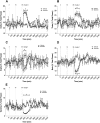Quantitative pharmacokinetic-pharmacodynamic modelling of baclofen-mediated cardiovascular effects using BP and heart rate in rats
- PMID: 27448216
- PMCID: PMC5055137
- DOI: 10.1111/bph.13561
Quantitative pharmacokinetic-pharmacodynamic modelling of baclofen-mediated cardiovascular effects using BP and heart rate in rats
Abstract
Background and purpose: While the molecular pathways of baclofen toxicity are understood, the relationships between baclofen-mediated perturbation of individual target organs and systems involved in cardiovascular regulation are not clear. Our aim was to use an integrative approach to measure multiple cardiovascular-relevant parameters [CV: mean arterial pressure (MAP), systolic BP, diastolic BP, pulse pressure, heart rate (HR); CNS: EEG; renal: chemistries and biomarkers of injury] in tandem with the pharmacokinetic properties of baclofen to better elucidate the site(s) of baclofen activity.
Experimental approach: Han-Wistar rats were administered vehicle or ascending doses of baclofen (3, 10 and 30 mg·kg(-1) , p.o.) at 4 h intervals and baclofen-mediated changes in parameters recorded. A pharmacokinetic-pharmacodynamic model was then built by implementing an existing mathematical model of BP in rats.
Key results: Final model fits resulted in reasonable parameter estimates and showed that the drug acts on multiple homeostatic processes. In addition, the models testing a single effect on HR, total peripheral resistance or stroke volume alone did not describe the data. A final population model was constructed describing the magnitude and direction of the changes in MAP and HR.
Conclusions and implications: The systems pharmacology model developed fits baclofen-mediated changes in MAP and HR well. The findings correlate with known mechanisms of baclofen pharmacology and suggest that similar models using limited parameter sets may be useful to predict the cardiovascular effects of other pharmacologically active substances.
© 2016 The British Pharmacological Society.
Figures






Similar articles
-
Combining radio telemetry and automated blood sampling: a novel approach for integrative pharmacology and toxicology studies.J Pharmacol Toxicol Methods. 2010 Jul-Aug;62(1):30-9. doi: 10.1016/j.vascn.2010.04.014. Epub 2010 May 23. J Pharmacol Toxicol Methods. 2010. PMID: 20507819
-
GABAB-ergic stimulation in hypothalamic pressor area induces larger sympathetic and cardiovascular depression in spontaneously hypertensive rats.Am J Hypertens. 1996 Oct;9(10 Pt 1):964-72. doi: 10.1016/0895-7061(96)00171-9. Am J Hypertens. 1996. PMID: 8896648
-
The Effect of the Toxic Dose of Baclofen on Selected Parameters of the Cardiovascular and Respiratory Systems.Bull Exp Biol Med. 2023 Oct;175(6):777-780. doi: 10.1007/s10517-023-05945-5. Epub 2023 Nov 18. Bull Exp Biol Med. 2023. PMID: 37979027
-
Pharmacokinetic-pharmacodynamic modelling in pre-clinical investigations: principles and perspectives.Eur J Drug Metab Pharmacokinet. 1993 Jan-Mar;18(1):41-7. doi: 10.1007/BF03220007. Eur J Drug Metab Pharmacokinet. 1993. PMID: 8335038 Review.
-
gamma-Aminobutyric acid and cardiovascular function.Experientia. 1983 Aug 15;39(8):845-9. doi: 10.1007/BF01990401. Experientia. 1983. PMID: 6307735 Review.
Cited by
-
Biobehavioral effects of baclofen in anxious alcohol-dependent individuals: a randomized, double-blind, placebo-controlled, laboratory study.Transl Psychiatry. 2017 Apr 25;7(4):e1108. doi: 10.1038/tp.2017.71. Transl Psychiatry. 2017. PMID: 28440812 Free PMC article. Clinical Trial.
-
Applications of Quantitative Systems Pharmacology in Model-Informed Drug Discovery: Perspective on Impact and Opportunities.CPT Pharmacometrics Syst Pharmacol. 2019 Nov;8(11):777-791. doi: 10.1002/psp4.12463. Epub 2019 Oct 25. CPT Pharmacometrics Syst Pharmacol. 2019. PMID: 31535440 Free PMC article.
-
Reduced Rank Least Squares for Real-Time Short Term Estimation of Mean Arterial Blood Pressure in Septic Patients Receiving Norepinephrine.IEEE J Transl Eng Health Med. 2019 Jun 4;7:4100209. doi: 10.1109/JTEHM.2019.2919020. eCollection 2019. IEEE J Transl Eng Health Med. 2019. PMID: 31475080 Free PMC article.
-
Semi-mechanistic modelling platform to assess cardiac contractility and haemodynamics in preclinical cardiovascular safety profiling of new molecular entities.Br J Pharmacol. 2020 Aug;177(15):3568-3590. doi: 10.1111/bph.15079. Epub 2020 Jun 18. Br J Pharmacol. 2020. PMID: 32335903 Free PMC article.
References
-
- Addae JI, Rothwell NJ, Stock MJ, Stone TW (1986). Activation of thermogenesis of brown fat in rats by baclofen. Neuropharmacology 25: 627–631. - PubMed
-
- Bain AR, Morrison SA, Ainslie PN (2014). Cerebral oxygenation and hyperthermia. Front Physiol 5: 92. doi: 10.3389/fphys.2014.00092. - DOI - PMC - PubMed
-
- Bexis S, Phillis BD, Ong J, White JM, Irvine RJ (2004). Baclofen prevents MDMA‐induced rise in core body temperature in rats. Drug Alcohol Depend 74: 89–96. - PubMed
Publication types
MeSH terms
Substances
LinkOut - more resources
Full Text Sources
Other Literature Sources

